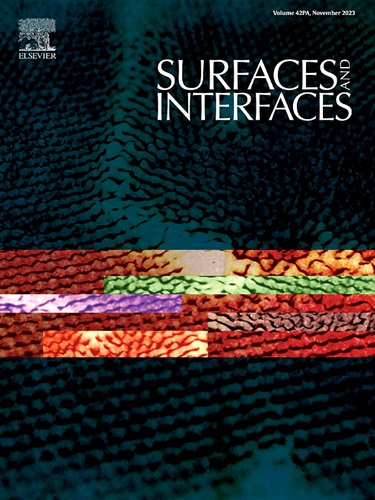Unraveling the mechanisms of organic contamination on gold pulse compression gratings: From cluster formation to stratified adsorption
IF 6.3
2区 材料科学
Q2 CHEMISTRY, PHYSICAL
引用次数: 0
Abstract
Organic contamination on gold pulse compression gratings significantly hampers the performance of high-power laser systems under intense laser irradiation. Investigating the adsorption mechanisms of organic contaminants on microstructured gratings is essential for addressing contamination issues and mitigating damage. In this article, we determine the microstructured surface aggregation characteristics of volatile dibutyl phthalate (DBP), the stratified distribution pattern of amorphous DBP clusters, and the distribution points of molecules within microstructures using experiments and cross-scale simulations (molecular dynamics and quantum chemistry). Our analysis of the Reduced Density Gradient (RDG) and charge transfer reveals that adsorption between organic molecules and the gold substrate primarily stems from non-covalent van der Waals and electrostatic forces induced by ester functional groups. Based on this theoretical study, we propose the "molecule-substrate" and "bimolecular" adsorption modes of DBP to elucidate the adsorption mechanisms. Investigating organic compounds' distribution and adsorption mechanisms on optical component surfaces is fundamental to high-power laser-induced damage studies. These insights facilitate the efficient, non-destructive removal of organic contaminants from gold gratings, enhancing the energy output threshold of inertial confinement fusion devices.

揭示金脉冲压缩光栅上有机污染的机制:从团簇形成到分层吸附
在强激光照射下,金脉冲压缩光栅上的有机污染严重影响了高功率激光系统的性能。研究有机污染物在微结构光栅上的吸附机制对于解决污染问题和减轻损害至关重要。在本文中,我们通过实验和跨尺度模拟(分子动力学和量子化学)确定了挥发性邻苯二甲酸二丁酯(DBP)的微观结构表面聚集特性,无定形DBP簇的分层分布模式以及分子在微观结构中的分布点。我们对还原密度梯度(RDG)和电荷转移的分析表明,有机分子与金衬底之间的吸附主要源于酯官能团诱导的非共价范德华力和静电力。在此基础上,我们提出了DBP的“分子-底物”和“双分子”吸附模式来阐明其吸附机理。研究有机化合物在光学元件表面的分布和吸附机制是高功率激光损伤研究的基础。这些见解有助于从金光栅中高效、无损地去除有机污染物,提高惯性约束聚变装置的能量输出阈值。
本文章由计算机程序翻译,如有差异,请以英文原文为准。
求助全文
约1分钟内获得全文
求助全文
来源期刊

Surfaces and Interfaces
Chemistry-General Chemistry
CiteScore
8.50
自引率
6.50%
发文量
753
审稿时长
35 days
期刊介绍:
The aim of the journal is to provide a respectful outlet for ''sound science'' papers in all research areas on surfaces and interfaces. We define sound science papers as papers that describe new and well-executed research, but that do not necessarily provide brand new insights or are merely a description of research results.
Surfaces and Interfaces publishes research papers in all fields of surface science which may not always find the right home on first submission to our Elsevier sister journals (Applied Surface, Surface and Coatings Technology, Thin Solid Films)
 求助内容:
求助内容: 应助结果提醒方式:
应助结果提醒方式:


